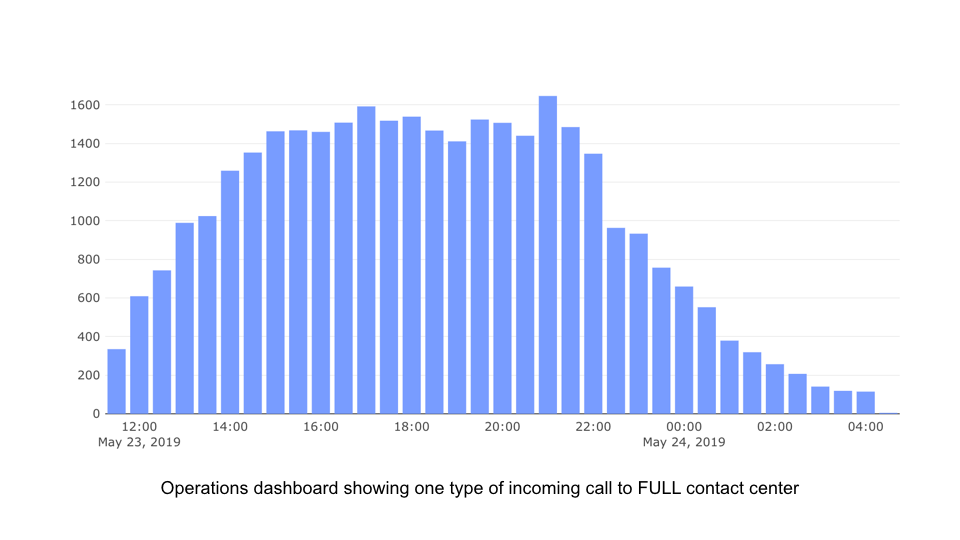
[ad_1]
Remote work affords organizations access to more talent and offers workers greater flexibility in their lives. With a vision for everyone to be able to work from anywhere, FULL Creative runs a contact center service using fully remote teams, tapping into the growing share of employees working remotely.

FULL agents answer calls on behalf of 7,000 clients of all sizes, from plumbers to parking garages to legal and medical professionals. Client experience agents make up about half of FULL’s 1,000 employees, and all work remotely from locations around the world. FULL makes extensive use of technology to route calls to remote staff over the Internet and coordinate teams of agents separated by geography and time zones.
The Importance of Real-Time Metrics in Managing Distributed Teams
FULL employs Amazon Connect for a variety of contact center functions, including telephony services, routing contacts to the right agent, and recording calls. While Amazon Connect handles the mechanics of contact center transactions for FULL’s front-line agents, FULL also has to analyze all the call data across its globally distributed workforce to ensure its business is running smoothly.
FULL’s quality team monitors random calls to verify contacts are provided the level of service required. The operations team tracks agent status—whether they are available, on a call, or on a break—to get insights into team performance and variations in call volume.
It is crucial for operations specialists to have access to real-time metrics, to ensure agent utilization is as expected. They identify when an agent may be spending too much time on one interaction or taking too long to retrieve information for the contact. They flag situations where too many agents are simultaneously unavailable. The operations team is on constant lookout for these and other anomalies, so that they can be rectified as quickly as possible.
Building a Live Dashboard to Support Operations
While Amazon Connect provides an off-the-shelf dashboard, it could not be customized to meet FULL’s requirements around filtering and aggregations. This led FULL to build its own live dashboard to gain insights into their operations and detect unusual situations that may arise.
FULL stores call records and logs in DynamoDB because it is well-suited to handle free-form data and changing schema—the number of fields in the data has grown over time. Event data from Amazon Connect streams through Amazon Kinesis to S3, where it is subsequently distributed to downstream services, including DynamoDB. FULL now needed a way to run SQL queries on the call data to power their dashboard, and briefly considered reading data from DynamoDB into Amazon EMR to run Hive queries. However, this would require significant effort to build out and manage, and query latency, backed by Hive, would be poor.
DynamoDB Live Sync and Fast SQL with Rockset
FULL then came across Rockset and decided to give Rockset a try. Connecting Rockset to DynamoDB was straightforward because of the built-in integration from the Rockset console and the ongoing live sync of data—data in Rockset is continually updated as new items are added to DynamoDB.

Rockset provides a SQL interface to semi-structured data in DynamoDB and native integration with Redash, allowing FULL to implement their analytics easily using these features. Compared to Hive and DynamoDB, which are not optimized for low-latency analytics, Rockset automatically builds multiple indexes on all the data it ingests to deliver fast analytic queries.
Driving Operational Excellence at FULL
Just as FULL uses technology to help its remote agents work as effectively as possible, FULL’s live operations dashboard on DynamoDB and Rockset is aiding its operations team in getting a better understanding of its business in real time.

“It’s extremely valuable for our operations team to have a complete picture of how our hundreds of remote agents are being utilized, as we need to be able to respond right away if there is any issue that may impact our service. Building our dashboard on Rockset was the easiest way to analyze our call data in DynamoDB and get real-time insights on the metrics we care about,” says Naresh Talluri, product manager at FULL Creative.
Alternative architectures for building their dashboard were either difficult to set up and maintain or did not have the capability to run complex SQL queries. Talluri listed the painless connection from DynamoDB to Rockset and the ability to perform joins, aggregates, and groups in SQL as some of the reasons for using Rockset in their stack. As for the future, he hopes to use Rockset in forecasting as well, improving the effectiveness of agent assignment based on historical data.
[ad_2]